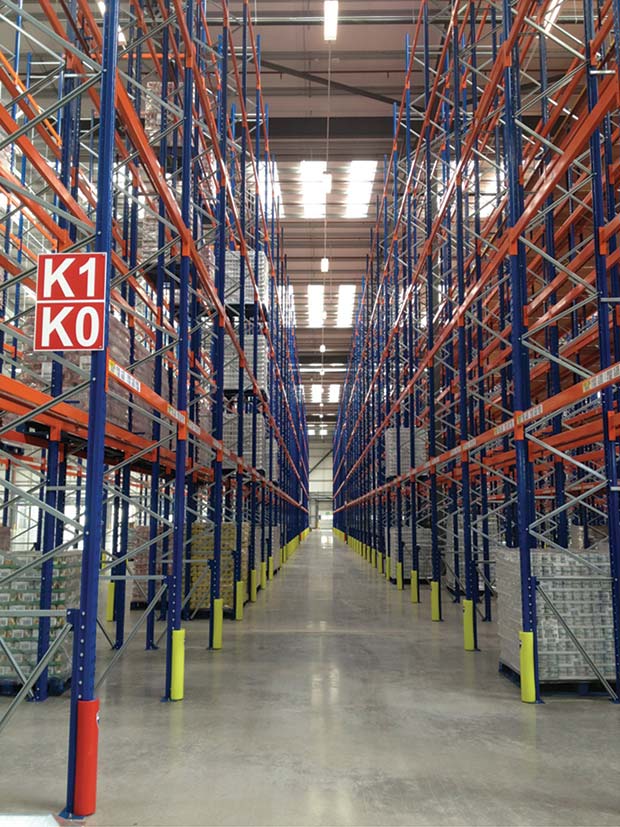Fluorescent lighting can be just as efficient as LED lighting, find out why from the experts in distribution facility lighting, says Shane Tate of engineering and management consultancy Tate Consulting
 Tate Consulting has recently completed work on a hat trick of multi-million pound projects for the world’s biggest retailing brand, Walmart. The latest in the series of developments is a £50m Asda chilled & frozen distribution centre in Bristol, and like its predecessors in Rochdale and Grangemouth, is one of the most environmentally sustainable buildings of its kind in the UK, achieving BREEAM Excellent and receiving an ‘A’ energy performance rating.
Tate Consulting has recently completed work on a hat trick of multi-million pound projects for the world’s biggest retailing brand, Walmart. The latest in the series of developments is a £50m Asda chilled & frozen distribution centre in Bristol, and like its predecessors in Rochdale and Grangemouth, is one of the most environmentally sustainable buildings of its kind in the UK, achieving BREEAM Excellent and receiving an ‘A’ energy performance rating.
Shane Tate, Partner at Tate Consulting explains, there are many luminaires and lamp choices on today’s market, which makes it a minefield when trying to select the most economical and energy efficient lighting installation to meet your application. One of the simplest and quickest way to work out whether one luminare is more efficient than another is to compare the lamp output efficiency, which is expressed as efficacy and is measured in lumens-circuit Watt (lm/W), or how much light is being emitted for every Watt Second of energy being used.
Table A indicates typical lamp efficiencies, and as you will see most of today’s lamps are comparable in terms of efficiency, even LED. The myth that LED is more efficient than any other lighting installation is simply not true.
When it comes to lamp efficiency, discharge lighting usually wins hands down. Sodium lamps have a peak wavelength close to the peak sensitivity of the human eye, typically making them the most efficient lamp available at present time. However, sodium lamps are not so easy to control, which generally rules out simple occupancy and daylight controls.
Similarly, metal halide lamps are highly efficient lamps too, but out of all the high-intensity discharge (HID) light sources metal halide lamps exhibit the best colour rendition properties, thus making them an excellent choice where colour rendition is important, but lamp control is not.
LED and fluorescent lamps have comparable lamp efficiencies. Most lamp manufacturers will quote typical lamp efficacies ranging from 82-90 lm/W, and 81 lm/W for a typical 49W T5 fluorescent lamp. Therefore it is fair to say that LED and fluorescent lamps have comparable efficiencies.
So next time a sales representative knocks on your door and tells you that LED lamps are the ‘best thing since sliced bread’, and that they are the most efficient on the market you know that they are comparable at best! In fact, unless the capital cost of an LED luminaire can match that of a typical fluorescent luminaire there is little opportunity for an LED lighting installation to provide greater benefits, whether it be capital cost, lamp replacement cost or energy in use cost when compared to a typical T5 fluorescent lighting installation over the whole life cycle of the lighting installation. Also, a word of caution, beware of unlike for like comparisons. If the results look too good to be true, they will be!

On a recent study carried out by Tate Consulting, we looked at the whole life cycle cost for five different lamp types for new distribution facility for one of the UK’s largest retailers to ensure that we were selecting the most energy efficiency luminaire over the buildings life. We compared LED, induction, metal halide, T5 fluorescent and sonT+ lamps. Graph B indicates the results of our whole life cycle study for the five lamp types.
Fluorescent and sodium lamps have the lowest 15 year whole life cycle cost at £667,818 and £675,104 respectively for a 24,000m2 ambient DC with a design illuminance of 150 lux. Interestingly though, a typical LED lamp installation cost a further £150,000 over the same 15 year life cycle period when compared to a T5 fluorescent lighting installation.
This is largely attributable to the increased capital cost of the LED luminarires and expensive LED lamp replacement costs over the same life cycle period. To compound matters, replacement fluorescent lamps are relatively inexpensive and do not require the lamp driver to be replaced every time the lamp is changed, which is usually the case with LED lamps.

When it comes to energy costs, uncontrolled sodium lighting has the lowest energy cost to operate. While LED and fluorescent lighting have almost identical running costs at £37,681/yr and £37,661 respectively. However, the LED and fluorescent lighting installations can be controlled and can take advantage of daylight and occupancy controls, which on average can yield anything from 15-30% energy savings. However, the actual savings can vary, and it very much depends on how a DC facility operates. Table C indicates the typical annual energy running costs results from our study for all five lamp types used in the study for a 24,000m2 DC operating on a 24/7 basis and electricity costs at 10p/kWh.
For further impartial advice on how to achieve the most energy efficient lighting installation for your DC, whether it be a new build or retro-fit contact:
Tate Consulting
Shane Tate
Email: shane.tate@tateconsulting.eu




Comments are closed.